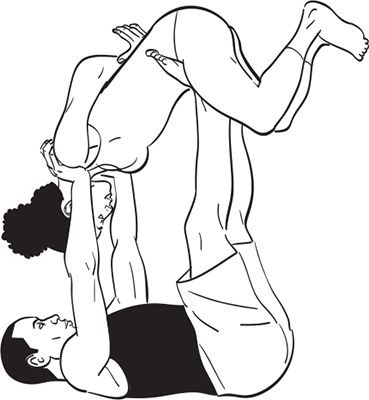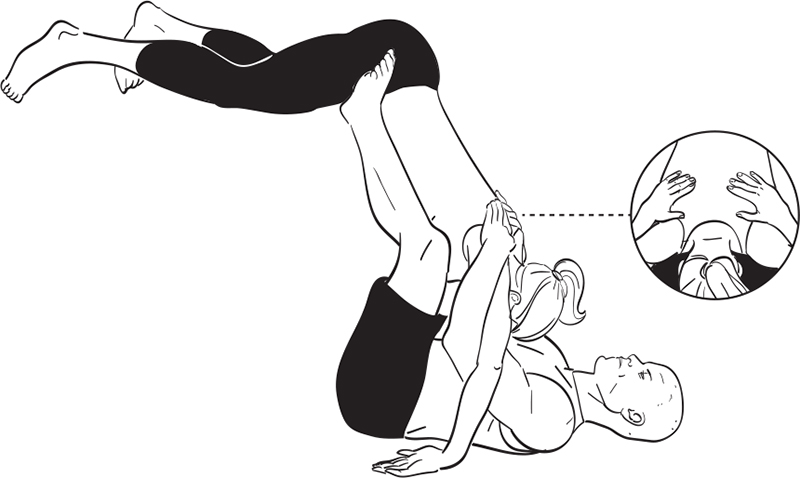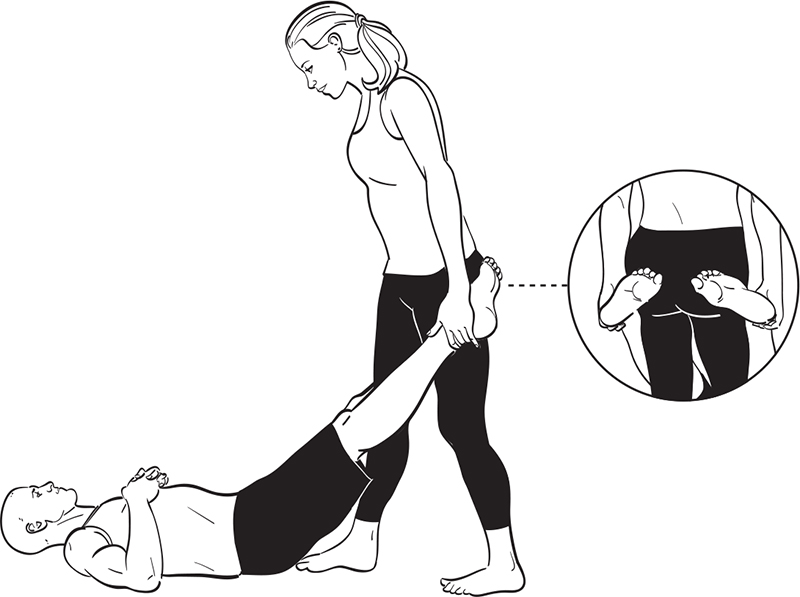

Jason Nemer (IG: @JASONNEMER, ACROYOGA.ORG) is a cofounder of AcroYoga, which blends the spiritual wisdom of yoga, the loving-kindness of Thai massage, and the dynamic power of acrobatics. Jason was a two-time U.S. Junior National champion in sports acrobatics and represented the U.S. at the World Championships in Beijing in 1991. He performed acrobatics in the opening ceremonies of the 1996 Olympics. AcroYoga now has certified teachers in more than 60 countries and hundreds of thousands of practitioners.
Spirit animal: Bunny
In 2015, I sat next to Jason at a dinner party at a friend’s house in L.A. Somehow, my lower-back pain—which had been plaguing me—came up, and he offered to “fly” me on the spot. Having no idea what that was, I agreed and ended up getting spun around in the air on his feet for about 15 minutes. It was surreal and seemed to defy the laws of physics. Two things worth noting: I weighed ~180 pounds and he weighs ~160 (he’s done the same with someone ~280 and 6'7"), and my back no longer hurt after the upside-down traction.
In the past, I’d always been repelled by yoga: too much mumbo-jumbo, too little excitement. AcroYoga is a different beast. You’ll endure the occasional Sanskrit, but it’s otherwise like a combination of body-weight strength training, dance (the “base” is the lead, and the “flier” follows), roughhousing (lots of wipeouts), and hip rehab (after ten sessions, my lower body felt 10 years younger).
It’s also the ultimate movement-based Prozac. In a culture where physical touch is taboo, this allows you to experience sensual but not sexual connection, all while getting incredibly strong and flexible. Last but not least, I laugh at least 50% of the time in all training sessions. It’s a wonderful balance to all the “serious” training that I do. If you’d like to see me both basing and flying, as well as teaching some basic techniques, just search “acroyoga” on youtube.com/timferriss.
Jason brought this delicious tea for us to drink during recording. It’s sometimes called “duck shit fragrance tea.” Supposedly, long ago in a region in China, the local populace wanted to keep this amazing tea for themselves, so they nicknamed it “duck shit” tea. Smart move. It was played down for centuries, until being rediscovered as very much non–duck shit flavored. Jason gets his from Quantitea (quantitea.com).
Jason has traveled the world for the last 6 years, never staying in one place more than 3 weeks. He travels with next to no luggage but insists on carrying a ukulele and a donkey’s load worth of tea.
The limiting factor for most people learning handstands is the wrists. This weakest link prevents you from getting enough upside-down practice. The FeetUp device addresses this—imagine a small padded toilet seat cushion mounted on a low stool. You stick your head through it, rest your shoulders on the padding, grab the two handles, and kick up into a headstand or handstand, with your shoulders supporting your weight. This allows you to work on alignment, tightness, positional drills (tuck, pike, straddle, etc.) in higher volume. The FeetUp is Jason’s preference, but it’s hard to find in the U.S. (en.feetup.eu). The BodyLift Yoga Headstand and Yogacise Bench are similar, or search for “yoga headstand bench.”
“Mo’ extension!” (more extension). In a handstand, you should push your shoulders as near (or past) your ears as possible. If you’ve ever done shrugs with dumbbells, imagine doing that with your arms overhead, and avoid arching your back. Also, the first knuckle (fist knuckle) of the index finger is prone to lifting off the ground in handstand practice. Jason calls this “the naughty knuckle.”
Facebook—Search your city’s name and “acroyoga.” The AcroYoga Berlin page, for example, has 3,650 playmates and training partners ready for you.
Acropedia.org (techniques)
• What do you believe that other people think is insane?
It’s Jason’s follow-up that I love the most, but this gives context:
“That you can trust people. You can trust a lot of people. You don’t have to live in fear of strangers. Strangers are just people you haven’t flown yet. It seems crazy to me that, in many cultures, we teach our children to fear and not talk to strangers. I’ve been all over the world. My mom was not happy when I was going to go to the Middle East for the first time. I was actually in Boston, about to lead a teacher training, when the Boston Marathon bombing happened. I had 15 students who were on lockdown for 24 hours.
“I got on the phone to my mom and I said ‘Look, Mom, you think Israel is dangerous. I’m in Boston. You cannot hide from danger.’ But I don’t think that’s a reason to not trust people. I’ve traveled the world in some very sketchy places and I’ve never had anything bad happen to me.
“I assume the best in people. I assume that I can trust them until they prove me wrong. When you do this practice enough, trusting is like a muscle that you flex. It doesn’t mean that I’m a cowboy with it. I have really good credit assessment.”
TIM: “Hold on—you said nothing bad has happened to you. How much of that is simply seeing things in the most positive light? Because you had your throwing knives [stolen by customs officers] in Panama. So shit happens, I’m imagining.”
Jason laughed, was quiet for a second, then answered:
“One of the things that happened to me that was really amazing—I had all of my objects liberated from me…. Basically, I didn’t want to work in restaurants [anymore], and I’m like, ‘I’m a yogi. I’m going to do this. I don’t care how hard it is. I love this.’ Boom. So I was living in my van.
“My 30th birthday, my friend throws me a party. That night I got a book on Buddhism, a case of coconuts, and I hung out with my friends. The next day, my van’s gone. My home is gone. Everything is gone. So I go crack a coconut and start reading about Buddhism because … what the fuck else am I gonna do? And here is talking about homelessness and wandering. I think, ‘That’s what I’m going to do.’ And that started my nomadic traveling. If I had stayed in San Francisco and tried to make it as a yoga teacher, AcroYoga wouldn’t be a worldwide practice.
“Let go of what’s not working and really assess what is working and ‘what can I be excited about?’ It’s not that bad things don’t happen to me. I don’t label a lot of things good/bad. [Instead, I ask] can I evolve from this? What do I want now? Where is my center now?”
• Most-gifted or recommended books
The Prophet by Kahlil Gibran: “I love really condensed, shakti [empowerment]-filled, energy-filled statements—something that you can read in a few minutes or you can read for your whole life.” [TF: This little tome is fewer than 100 pages long. Spend the extra $5 for the version with the author’s illustrations.]
Tao Te Ching by Lao Tzu: Jason travels with this book. “Oftentimes before meditation, I’ll just open it randomly to a page. I read about something and then just have that be what I steep in as I sit.” (See Rick Rubin, here, and Joshua Waitzkin, here.) When I asked Jason via text which translation he liked, he joked “Tao de Chinga tu madre” (ah, my friends), and then specified: Stephen Mitchell.
• Jason’s best $100 or less purchase
Jason loves disc (Frisbee) golf and travels with discs. In particular, Innova’s Roc mid-range disc and his “go-to driver,” the TeeBird. He plays the game, but he also, on rare occasions, lets a disc go:
“I correct people when they get really serious because there are people who have caddies. For real. Those people think it’s a sport. It’s a pastime, no matter how hard you work at it. It’s a piece of plastic, and you’re throwing it around….
“But to watch a disc fly for about a minute, it’s magical…. In yoga, there’s this philosophy, svaha. I call it ‘Fuck it, let go.’ … I like to throw Frisbees off of really high objects. And when I’m in these very ceremonial places like Machu Picchu, it’s like, ‘What am I releasing?’ So it’s an intentional act.”
“Play! Play more. I feel like people are so serious, and it doesn’t take much for people to drop back into the wisdom of a childlike playfulness. If I had to prescribe two things to improve health and happiness in the world, it’d be movement and play. Because you can’t really play without moving, so they’re intertwined.
“Treadmills kill your spirit. There are reasons and times to do treadmills, but if that is your only way of moving your body, you’re selling yourself short. There are much cooler ways to move your body, way more fun things, and I just happened to have the good fortune to learn a lot of these really cool things. So play.”
On theoretical yoga versus applied yoga: “I also feel that there’s a ceiling on yoga, and the ceiling is: You have all this amazing knowledge and all this amazing practice, but how are you bringing that into the world? What happens when you’re in traffic? How are you with your mom? Do you talk to your mom? Do you tell her the truth?”
AcroYoga is a blend of three complementary disciplines: yoga, acrobatics, and therapeutics.
The therapeutics were brought into the fold by Jenny Sauer-Klein, the other cofounder of AcroYoga (along with Jason Nemer, here), and resemble suspended Thai massage. So much so that it’s often referred to as “Thai and fly.”
I’ve seen Jason blow high-level acrobats’ minds (even those from Cirque du Soleil) with Folded Leaf (here), perhaps the easiest of all AcroYoga therapeutic poses. Be forewarned that it’s sometimes jokingly referred to as “Leaf Blower,” as it puts face close to groin. If your partner’s not ready to be inches from your crotch, Hippie Twist (here) is a Disney-friendly alternative.
To intro you to the “Acro” world, I’ll share a few of my favorite moves from therapeutic flying. They are much safer than acrobatics, which require a teacher and spotters.
In 5 minutes or so, I’ve used the following to fix lower-back pain in at least six of the people featured in this book. “I haven’t felt this type of release and relaxation in years … or ever” is a common response. Take it SLOW and enjoy! If it’s uncomfortable, you’re not doing it right. Do this on a mat or grass, and I suggest practicing the moves in the order listed.
Anything in quotation marks is what I’d say as a base (the person on their back) teaching a first-time flyer (the person getting inverted). Good rule for Acro and for life: Tell people what you want, not what you don’t want, and keep it simple. In other words, say “Stronger elbows” and not “Don’t bend your arms.” Say “Softer feet” and not “Stop poking my abs with your toes.”
There are a million ways to teach Acro basics well, of course. The following is my personal preference.



Repeat steps 1 to 7 of Hippie Twist (opposite).


At the end of an AcroYoga session, the base’s legs are typically fried. This is when “Leg Love” comes in—the flyer helping to decompress and restore the base’s legs and hips. There are dozens upon dozens of techniques (e.g., “Bus Driver”), but this one gives a fantastic bang for the buck. Since I’ve never heard a name for it, I’ll call it “Gravity Boots,” as the effect is similar.
Even used independent of AcroYoga, this exercise has therapeutic value.

As Tony Robbins would say, “The quality of your questions determines the quality of your life.”
When I was interviewing athletes and coaches from 2008 to 2010, digging up non-obvious tactics for The 4-Hour Body, I sent different combinations of the following questions to dozens of experts. These can be modified for any skill or topic, not just sports. Just replace [SPORT] with what you want to learn, and track down your mentors. You can often find past gold and silver medalists willing to answer these via Skype for $50 to $100 per hour, which is an incredible steal and could save you years of wasted effort.
In the case of basketball, I added four more to the above. The following questions were emailed to Rick Torbett, the founder of Better Basketball:
I received his email responses and, 2 days later, hit 9 out of 10 free throws for the first time in my life. Then, on Christmas Eve, I went bowling and realized that many of the basketball principles (e.g., determining eye dominance to move your vertical “center line”) applied to the lane, too. I scored 124, my first time over 100 and an Everest above my usual 50 to 70. Upon returning home, I immediately went outside and sank the first two 3-pointers of my life. That’s a hell of a lot of fun. It all starts with good questions.